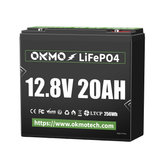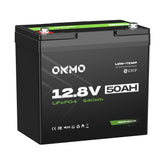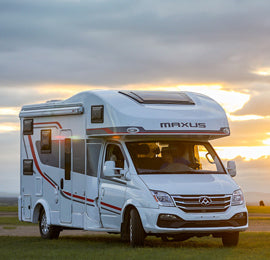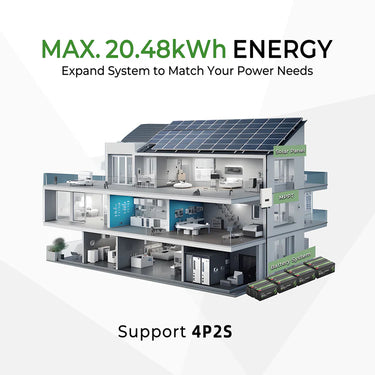How 6V Golf Cart Batteries Power a 48V Golf Cart ?
 At first glance, a 6-volt (6V) battery may seem too weak to power an entire golf cart. After all, most golf carts run on 36V or 48V systems—how could a small 6V battery handle that kind of load?
At first glance, a 6-volt (6V) battery may seem too weak to power an entire golf cart. After all, most golf carts run on 36V or 48V systems—how could a small 6V battery handle that kind of load?
The answer lies in the power of connection. Golf carts use multiple 6V deep cycle batteries connected in series to build the voltage required to run the motor efficiently and safely.
1. Understanding Golf Cart Battery Systems
Most modern golf carts operate on either:
-
36V systems (common in older or smaller carts)
-
48V systems (common in newer or high-performance carts)
Each golf cart uses several batteries connected in series to reach the total system voltage.
Here’s how it works:
| Golf Cart System | Battery Type | Number of Batteries | Total Voltage |
|---|---|---|---|
| 36V | 6V batteries | 6 | 6V × 6 = 36V |
| 48V | 6V batteries | 8 | 6V × 8 = 48V |
| 48V | 8V batteries | 6 | 8V × 6 = 48V |
| 48V | 12V batteries | 4 | 12V × 4 = 48V |
So, in a 48V golf cart, eight 6V batteries are wired in series to create the full 48V output.
2. How Series Connection Works
In a series connection, the positive terminal of one battery connects to the negative terminal of the next.
-
Voltage adds up, while
-
Capacity (Ah) remains the same.
For example:
If each 6V battery is rated at 200Ah, then eight batteries connected in series will produce:
-
Voltage: 6V × 8 = 48V
-
Capacity: 200Ah
-
Total Energy: 48V × 200Ah = 9,600Wh (or 9.6kWh)
That’s more than enough energy to power a golf cart for 20–40 miles, depending on terrain and load.
 3. Why Use 6V Batteries for Golf Carts?
3. Why Use 6V Batteries for Golf Carts?
There are good reasons why 6V batteries remain a favorite in golf cart setups:
✅ Deep Cycle Design
6V batteries are designed for deep discharge and long-duration use. They can handle hundreds of full charge cycles, ideal for golf carts that operate several hours per day.
✅ Higher Capacity per Cell
Compared to 8V or 12V batteries, a 6V battery typically has thicker plates and more capacity per cell, leading to better durability and longer runtime.
✅ Ease of Replacement
Each battery is smaller and easier to replace individually. If one battery fails, you can swap it without changing the entire pack.
✅ Stable Power Output
6V deep cycle batteries deliver more consistent voltage, meaning smoother acceleration and steady performance throughout the discharge cycle.
 4. The Role of Deep Cycle Batteries
4. The Role of Deep Cycle Batteries
Golf carts rely on deep cycle batteries, not starting batteries.
-
Starting batteries are built to provide short bursts of high current (like in cars).
-
Deep cycle batteries, on the other hand, are designed to deliver a steady flow of power over a longer period — exactly what a golf cart motor needs.
Most 6V golf cart batteries are lead-acid deep cycle designs, though LiFePO4 lithium batteries are quickly becoming a popular alternative due to their superior performance.
5. Lead-Acid vs. LiFePO4 Golf Cart Batteries
| Feature | 6V Lead-Acid Battery | LiFePO4 (Lithium) Battery |
|---|---|---|
| Weight | Heavy (≈30 kg each) | Light (≈10 kg each) |
| Cycle Life | 500–700 cycles | 3000+ cycles |
| Maintenance | Needs water refilling | Maintenance-free |
| Voltage Stability | Drops during discharge | Stable output |
| Charging Time | 6–8 hours | 2–3 hours |
| Cost | Lower upfront | Higher upfront, but long-term savings |
🔋 LiFePO4 batteries (like OKMO 48V golf cart series) are becoming the top choice for users who want lightweight design, faster charging, and long service life.
 6. Example: 48V Golf Cart Using 6V Batteries
6. Example: 48V Golf Cart Using 6V Batteries
A 48V golf cart equipped with eight 6V 200Ah batteries can deliver:
-
9.6kWh of stored energy
-
Stable torque output for climbing hills or carrying passengers
-
Run time of 3–5 hours per full charge
However, replacing that same pack with a 48V 105Ah OKMO LiFePO4 battery gives similar or better performance at half the weight, with zero maintenance and over five times the lifespan.
7. Maintenance Tips for 6V Golf Cart Batteries
If you’re still using traditional 6V lead-acid batteries:
-
Keep terminals clean and corrosion-free.
-
Check water levels regularly (use only distilled water).
-
Charge after every use — avoid deep discharges below 20%.
-
Store in a cool, dry area when not in use.
Proper care ensures maximum performance and longevity.
 8. Frequently Asked Questions (FAQ)
8. Frequently Asked Questions (FAQ)
Q1: Can I replace my 6V batteries with 12V ones?
Yes, but only if the total system voltage matches your motor and controller. For example, four 12V batteries can replace eight 6V ones in a 48V setup, but you’ll likely lose runtime because 12V batteries usually have smaller capacity.
Q2: How long do 6V golf cart batteries last?
Typically 3–5 years for lead-acid batteries with regular maintenance. LiFePO4 batteries can last 8–10 years.
Q3: Can I mix 6V and 8V batteries?
Not recommended. Mixing voltages causes imbalance, uneven charging, and potential damage to your motor controller.
Q4: What’s the best battery upgrade for my golf cart?
If you’re upgrading from lead-acid, consider OKMO 48V LiFePO4 Golf Cart Battery — lightweight, safe, and delivers 3000+ cycles with zero maintenance.
 Conclusion
Conclusion
6V golf cart batteries may seem small, but when connected in series, they provide the full power needed to move your golf cart efficiently and reliably.
Their deep cycle nature makes them ideal for steady, long-term energy delivery.
For modern users seeking enhanced performance, safety, and long lifespan, LiFePO4 batteries are the future of golf cart energy systems — combining advanced technology with maximum efficiency.








